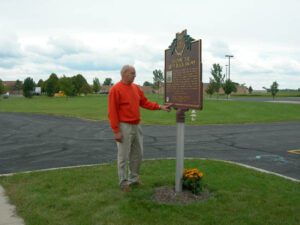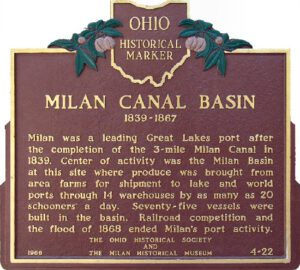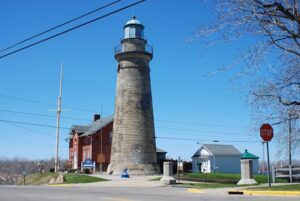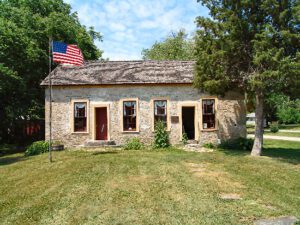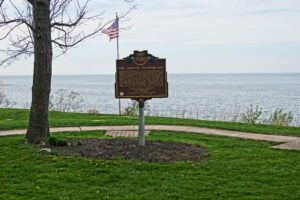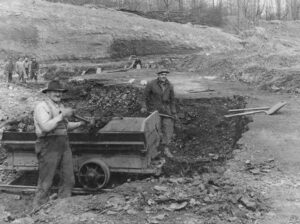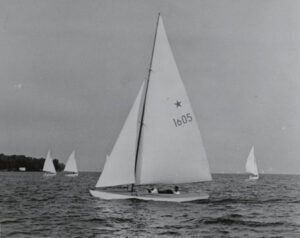, OH
The landscape of northwest Ohio was formed by melting ice and the glacial lakes left behind in its wake. Because of the low gradient (3 feet fall per mile) to the northeast, the flat lacustrine plain evolved into a large swamp. A massive swamp forest with huge hardwoods, broken only sporadically with intermittent wet prairies and savannahs, dominated the landscape. Both prehistoric and historic Indians farmed the flood plains of the Maumee River and its tributaries: Auglaize, Tiffin, and Blanchard rivers. (continued on other side)
, OH
Milan was a leading Great Lakes port after the completion of the 3 mile Milan Canal in 1839. Center of activity was the Milan Basin at this site where produce was brought from area farms for shipment to lake and world ports through 14 warehouses by as many as 20 schooners a day. Seventy-five vessels were built in the basin. Railroad competition and the flood of 1868 ended Milan’s port activity.
, OH
Lighthouse and keeper’s dwelling, erected in 1871 to replace the 1825 structures designed by Jonathan Goldsmith. From the time it guided early settlers into the Western Reserve until it was decommissioned in 1925, this station served Great Lakes shipping for its most important 100 years. The present, well-proportioned tower, constructed of Berea sandstone, is an outstanding engineering achievement.
, OH
On July 18, 1907, Dr. Lee deForest broadcast the first ship-to-shore radio message from the steam yacht Thelma. The communication provided quick, accurate race results of the Annual Inter-Lakes Yachting Association (I-LYA) Regatta. Frank E. Butler, a Monroeville, Ohio, native and assistant to deForest, was stationed in the pavilion at Fox’s Dock (known today as The Jet Express Dock) and received the radio transmission. The creation of the vacuum tube by deForest permitted the rapid development of radio and eventually television. The inventor disliked the existing term “wireless,” and chose a new moniker — “radio.” On this site wireless-transmission radio broadcasting was born.
, OH
Built in 1822, this native limestone structure was the home of Benajah Wolcott, first keeper of the Marblehead Lighthouse (originally called the Sandusky Bay Light), and his second wife, Rachel Miller Wolcott. Benajah maintained the lighthouse from 1822 until his death ten years later. After Benajah’s passing the U.S. Government appointed Rachel as the keeper, making her the first female lighthouse keeper on the Great Lakes. The building is the oldest known residence still standing in Ottawa County and is a fine example of a “hall-and-parlor house,” an early American home design.
, OH
Following the completion of the Erie Canal from Albany to Buffalo, New York, Lake Erie became an important link in an all-water route for immigrants traveling from the eastern seaboard into the Midwest. The 600-ton lake steamer G.P. Griffith, launched in 1847, was one of dozens built to capitalize on this booming trade. On June 17, 1850, the Griffith, outbound with more than 300 passengers on a three-day voyage from Buffalo to Toledo, caught fire and burned about 220 yards from this overlook. Many of the German, English, Irish, and Scandinavian settlers were laden with money sewn into their clothing, and few reached shore. Contemporary accounts listed 286 lost. Most were buried in a mass grave on the beach, since reclaimed by Lake Erie. The Griffith incident remains one of the worst maritime disasters on the Great Lakes.
, OH
Agriculture dominated the economy of southeastern Ohio’s Morgan County until the 1940s when harvests dwindled, the population declined, and land values dropped. Surface mining the area’s rich underground coal deposits replaced agriculture as the major industry and revitalized the declining local economy. As the nation’s demand for electricity grew over the next half-century, so did the demand for coal as fuel for nearby power generation plants. During mining’s heyday in the 1960s to the late 1980s, American Electric Power’s former Central Ohio Coal Company subsidiary employed nearly 1,000 people. Nearby communities-such as Cumberland, Caldwell and Chandlersville-thrived. As time passed, however, the robust coal industry was hit hard by environmental regulations that reduced the market for the area’s high-sulfur coal. In turn, mine work forces shrank considerably and local businesses closed. (continued on other side)
, OH
In total area, Lake Erie is the twelfth largest freshwater lake in the world and the most shallow of the five Great Lakes. It is about 210 miles long, 57 miles wide, with a shoreline of approximately 871 miles, and has a maximum depth of 210 feet. It served as a passage for early explorers navigating by canoe into the interior of North America and has since become a key link to commercial shipping on the Great Lakes. Lake Erie is an important water resource for recreation and tourism as well as for municipal and industrial use. Its warm, shallow waters harbor a diverse and abundant fishery, primarily known by anglers for fine catches of walleye, yellow perch, and smallmouth bass.


